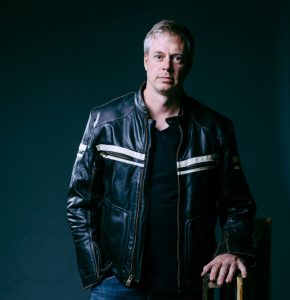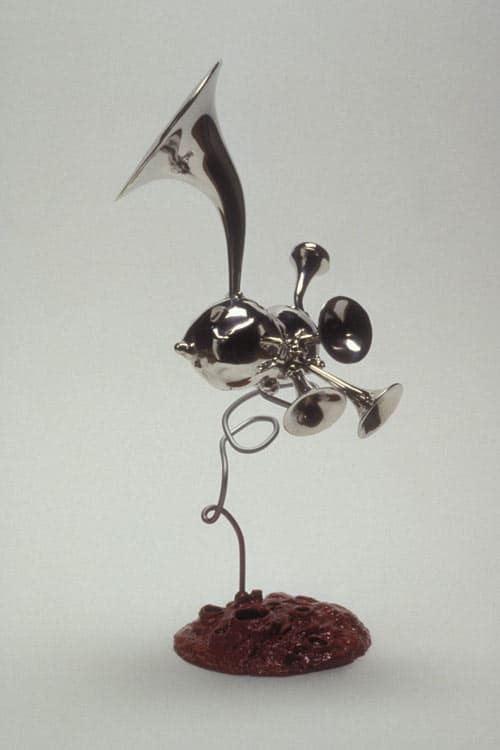Brian McCutcheon
On the “About” page of Brian McCutcheon’s website appears perhaps one of the scariest artist photos on the Internet. Under his right eye is a lurid green-and-purple bruise, and a few of his teeth seem to have been bloodied or knocked out completely. It’s an odd kind of self-presentation, but one that makes perfect sense once you get to know his work better. In photography, sculpture, and installation for the last 15 years, McCutcheon has been exploring the theme of masculinity in America, specifically Midwestern ideas about maleness, and that has included a series of “funhouse” portraits of that good-old high-school nemesis—the bully.
McCutcheon has taken on other masculine themes and emblems—racing cars, astronauts, road construction, even barbecuing—in a mind-boggling array of mediums. Most of his projects are suffused with wit and ingenuity because, he says, “the making of art comes from a process of play.” Take, for instance, a work called Taurus (2004), which at first blush looks like a Color Field or AbEx painting from circa 1955-65. But the 80-inch-long diptych is based on a distorted photo of his reflection in a car panel, realized in automotive paint on aluminum.
The artist claims his earliest “sculptural experiences” date back to when he was 16 and picked out his first car, doing the necessary tinkering to bring it up to speed. As a teenager growing up in Traverse City in northern Michigan, he worked with an uncle who was a mechanic and in school became fascinated with brass instruments, particularly the trombone, which was about “discipline and a desire to be creative,” he says. But it would be a while before he would settle on a career in art. “I ended up training in architecture at the University of Michigan, though the projects weren’t traditional buildings. They were more like sculpture.” (One of his inspirations was Kent Hubbell, an enormously popular architecture teacher now at Cornell. “I never had a mentor relationship with him, says the artist, “but I saw in his work and manner something to aspire to.”)
After his father was killed in a freak accident with a snowplow, McCutcheon decided he was generally unhappy in Michigan, packed his bags, and moved to Colorado. At the state university in Fort Collins, he had a couple of “phenomenal mentors,” and one of them, a ceramicist of some renown named Richard DeVore, turned him on to making art. That led to an MFA from Cranbrook Academy in 1995, with a degree in ceramics, but by the time he left, he says, “I wasn’t working in clay anymore. I started looking more at images and using personal stories, and I started fabricating artwork for other people.”
He dates his first mature work to a residency at the Bemis Center for Contemporary Art in Omaha, Nebraska, in 2000, and to a kitschy found ceramic figurine that McCutcheon glazed with automotive paint. Around the same time he made a series of semi-abstract sculptures sprouting hornlike shapes. “I did these while I was also learning to play the bagpipes,” he recalls, “and I made a good living playing at funerals, weddings, even the Wing Bowl the Friday before the Super Bowl.”
But the serious play with masculine imagery seems to hit its stride with Trailer Queen II in 2003, a sculpture made from a Weber grill with exhaust pipes and the kind of flame-like detailing in gold paint that you’d find on a showy, souped-up deuce coupe. “I wanted to be more honest in the materials I used,” he says. “And I was reading hot rod magazines and thinking about masculinity in the Midwest.”
About five years ago, McCutcheon was approached by Lisa Freiman, a curator at the Indianapolis Museum of Art, to do a solo exhibition. Called “Out of This World,” it featured an adaptation of an actual space probe, replicas of uniforms won by astronauts, videos of John Glenn’s voyage re-enacted by the artist’s son, Angus, and a series of “alien landscapes”—photos of McCutcheon and Angus in astronaut suits going about everyday tasks in suburban Indianapolis
“When I was first asked to do a project for the museum,” he recalls, “my son was four years old and interested in space-related imagery. We were reading together about the space programs in the 1960s, and I quickly realized that I was four years old at the same time that Apollo landed on the moon. It seemed natural to make the connection between the launch of the space program and the risk-taking of boyish behavior and imagination.”
McCutcheon divides his time between devoting himself to his own projects—such as a body of sculptures that use road-construction imagery—and working as a professional fabricator (his skills include mold making and casting, conservation and building custom cars). Together with his architect-wife, Donna Sink, he has realized several large-scale art commissions, such as a public lending library in Indianapolis.
And he often still “collaborates” with Angus. “Sometimes I don’t know if he distinguishes his work from mine,” the artist says. ”He is happy to art direct on videos or during production, but that seems natural because he engages me on his own creative projects for school, where I do my best to act as assistant.”
Ann Landi
 Brian McCutcheon’s work is private and public collections nationwide, including the Indianapolis Museum of Art and the Bemis Center for Contemporary Art. He has been the recipient of a Pollock-Krasner Foundation grant, and has exhibited in Scotland, Belgium, and Indonesia. His next public art commission is for the Victoria Gardens at Rancho Cucamonga, CA. More about his work can be found at brianmccutcheon.com. A brief, lively interview and survey, including McCutcheon’s production of a customized forklift, is on YouTube.
Brian McCutcheon’s work is private and public collections nationwide, including the Indianapolis Museum of Art and the Bemis Center for Contemporary Art. He has been the recipient of a Pollock-Krasner Foundation grant, and has exhibited in Scotland, Belgium, and Indonesia. His next public art commission is for the Victoria Gardens at Rancho Cucamonga, CA. More about his work can be found at brianmccutcheon.com. A brief, lively interview and survey, including McCutcheon’s production of a customized forklift, is on YouTube.
Top image: Brian McCutcheon, Lounge (2011), cibachrome print, 46 by 56 inches.

